Xin chào,
To complete the e-visa application form online, you are required to upload a digital copy of your passport + your latest portrait photo.
Use your phone and take a picture of your passport’s bio page. This is the information page of your passport that has your complete name, nationality, passport number, etc.
Here is the sample
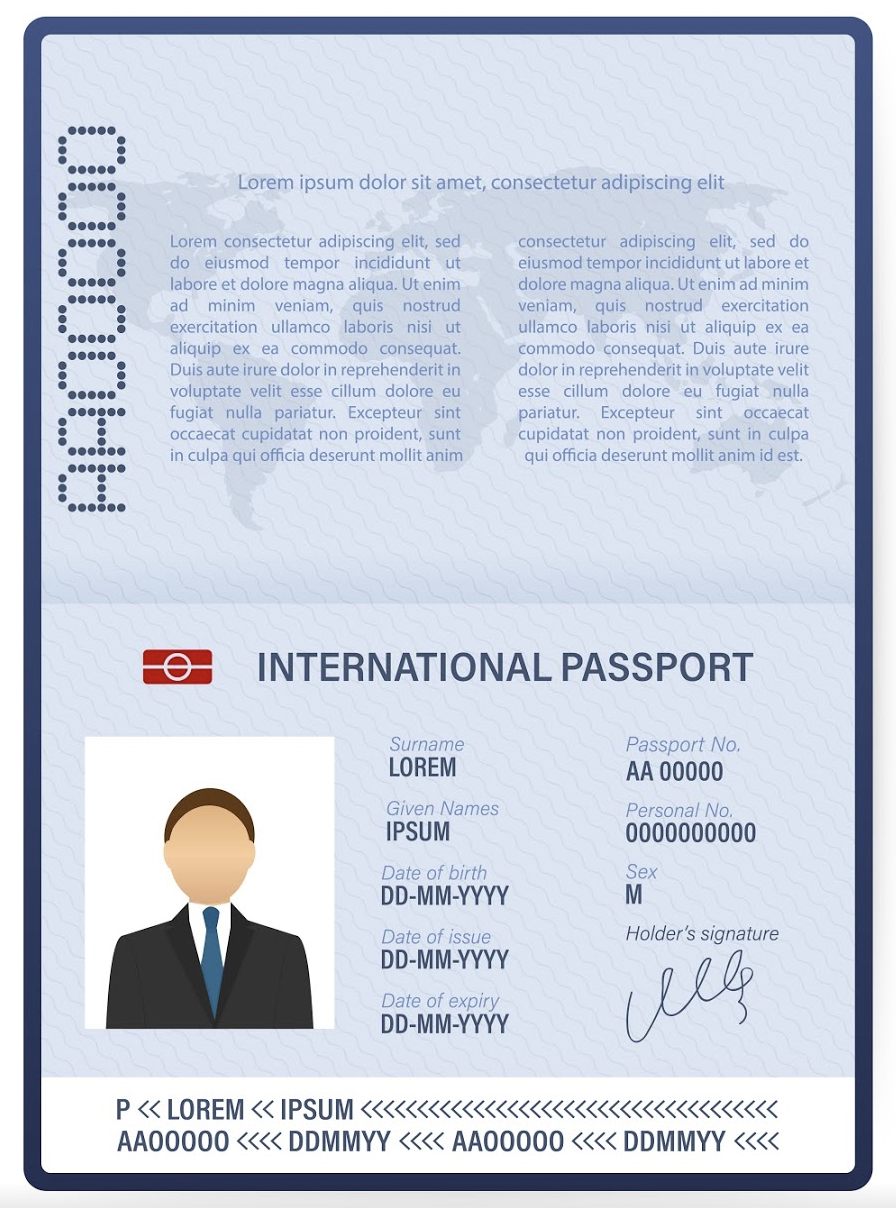
Passport-sized digital photo – Use your phone to take the portrait photo.
The portrait photo should have a white, blue, or brown… background. It should display your face clearly and must be taken recently. Jpeg, PNG, JPG format.
Note : Please do not wear glass and make sure no object behind.

Cảm ơn ./.

One of Southeast Asia’s most popular tourist destinations, Vietnam is a hotspot for nature lovers, thrill seekers and foodies. The picture-perfect landscape, friendly locals and culture make for an incredible experience. Its capital, Hanoi has an old-style feel to it unlike the rest of the country and its winding roads are easy to get lost in. Whereas Ho Chi Minh City is the polar opposite with skyscrapers and modern architecture. Vietnam has so much to offer with delicious food as well as natural wonders like Ha Long Bay. This two-week itinerary will help guide you through the must-visit sights of Vietnam.
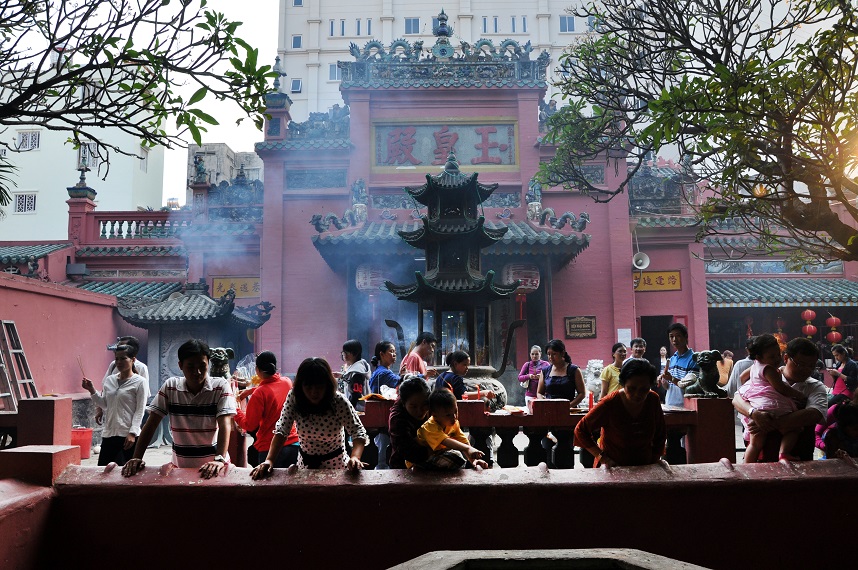
Dive into Vietnamese culture and life by starting your incredible two-week journey in Ho Chi Minh City. Unlike any other place, Ho Chi Minh helps immerse you in the culture and offers some great sightseeing experiences. After trying out your first cup of Vietnamese coffee, definitely visit the Ben Than market and the War Remnants Museum. From Ho Chi Minh City you can also take day trips to both the Mekong Delta and Cu Chi Tunnels. Whether you’re on a budget or can splurge on accommodation, there’s plenty of options. Pham Ngu Lao Street is a well-known backpackers street where you can find lots of hostels, bars and cafes.
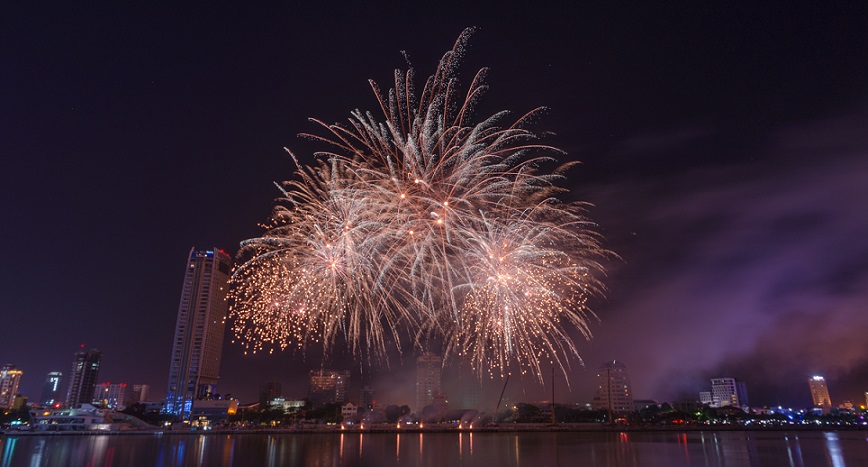
From Ho Chi Minh City fly to Da Nang to reduce time spent travelling and make the most out of the two weeks you have available. Internal flights within Vietnam are usually very good value and can be booked in advance or last minute. As Da Nang is so close to Hoi An, you can spend a morning or afternoon exploring the city before heading to Hoi An. The Marble Mountains in Da Nang are worth a visit and offer incredible views of the area.
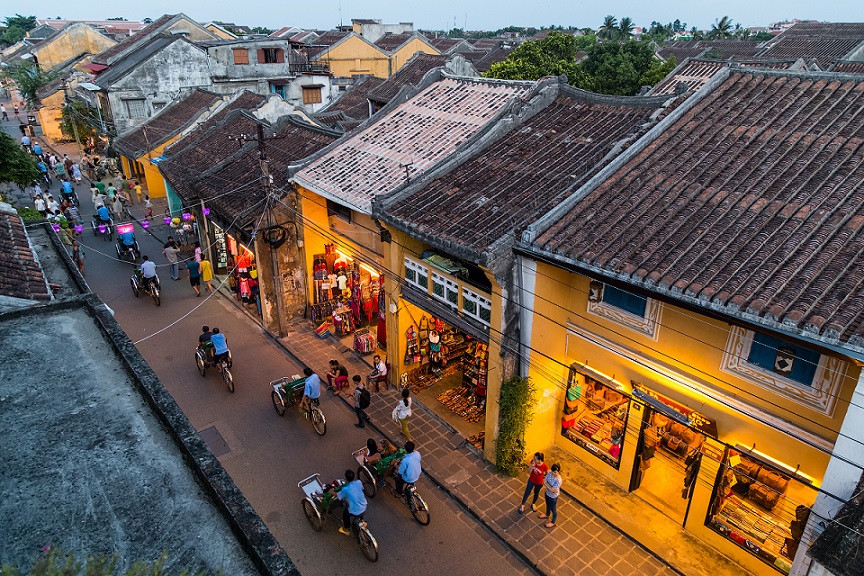
Take a bus or taxi 30km to reach the UNESCO World Heritage Site of Hoi An. An extremely popular designation due to its beauty and array of Chinese lanterns that come to life at night. Wander through the streets, visit the Japanese bridge and try out some delicious street food.
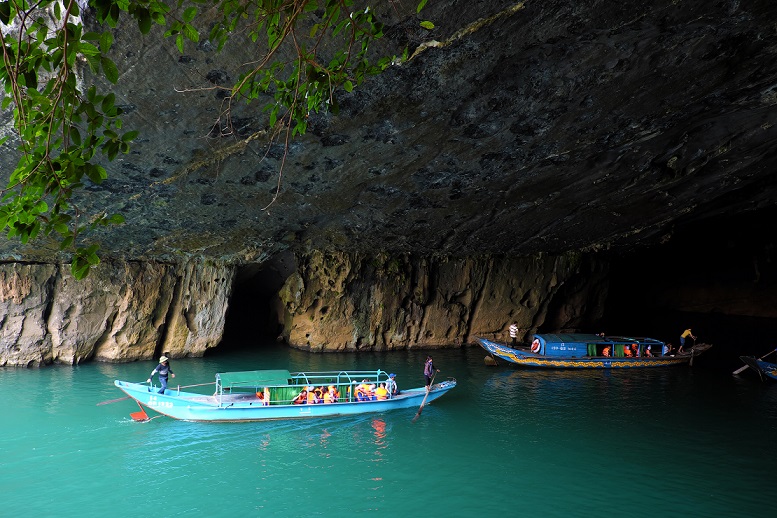
You can either travel by bus or train to reach the national park. Buses leave Hoi An regularly and take the better part of a day to reach their destination. The other option is to take the train from Da Nang to Dong Hoi, then take a bus or private car from Dong Hoi to Phong Nha. If you can it’s best to travel at night so that you can utilise the time you have as much as possible and save on accommodation as well. Phong Nha has three public caves which can be visited. A tour to the Dark Cave includes swimming, zip lining and kayaking through the cave. If you’re looking for something a bit calmer, the Paradise Cave tour includes a boat ride and a chance to explore the cave.
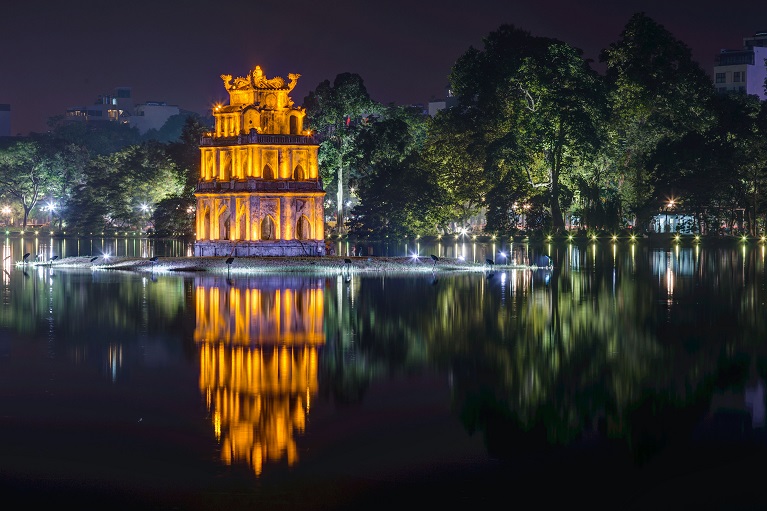
Hanoi is not only the capital but also the northern hub and connects many popular destinations together. Both journeys to Ha Long Bay and Sapa will leave from Hanoi so you will be coming and going through the popular city a few times. Explore and get lost in the old streets of Hanoi. Navigate through alleys in the Old Quarter with markets, street food stalls and shops. Take a wander around the Hoan Kiem Lake in the morning and try out some Hanoi delicacies such as an egg coffee, which is surprisingly tasty.
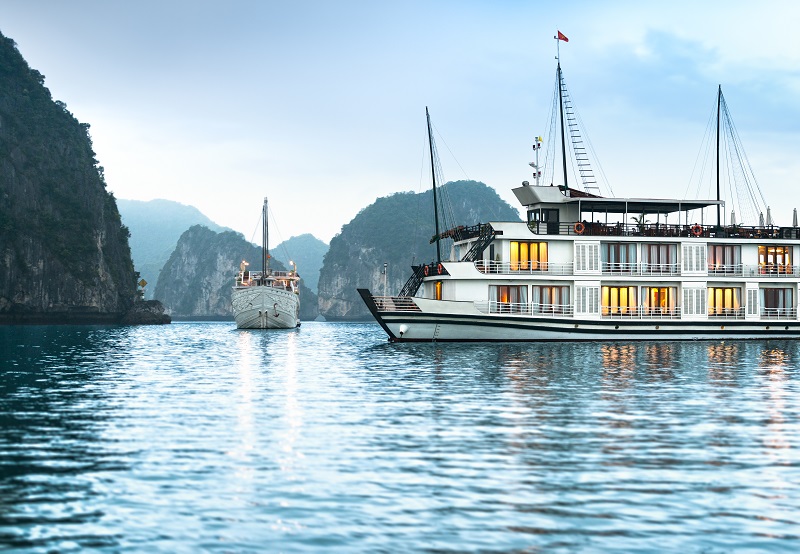
Most visitors to Ha Long Bay book a tour from Hanoi. There are several options available and many hostels and hotels throughout Hanoi can arrange them for you. Spending a night in Ha Long Bay is an amazing experience and the natural beauty of the area is astounding. You’ll be picked up directly from your hotel and taken by bus to the harbour. Then you’ll board a boat and spend the night in the bay. The majority of trips include swimming and kayaking. For those looking to party, the three-day and two-night Castaway tour is for you.
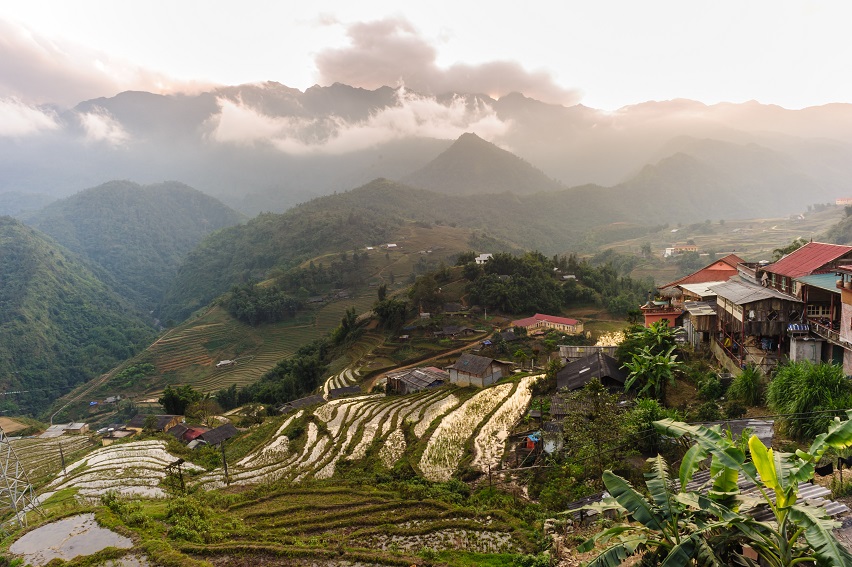
Sapa is a beautiful destination to finish off your journey. The mountainous region is breathtaking and renowned for its rice paddies, trekking and minority villages. You can reach Sapa by train, bus or private car hire from Hanoi. While visiting, there a number of hiking options ranging from easy to hard, so make sure you have the energy and the ability to carry it out. If you’ve got the time, the hike up Fansipan mountain leads to spectacular views but it is very physically challenging. If that’s not for you, take the cable car up the mountain to get the rewards of the view without the hard work.
Cat Cat Village is great to explore in Sapa and leads to a waterfall. The mountain town’s relaxing atmosphere and unique culture are truly wonderful. Next head back to Hanoi to catch your plane home and start planning your next adventure.
Must See UNESCO Sites in Vietnam
From north to south, Vietnam surprises with its beauty and impresses with its complex history. If you don’t have time to visit all the World Heritage sites, don’t worry. Just follow our guide below to discover the five UNESCO sites you can’t leave Vietnam without seeing:
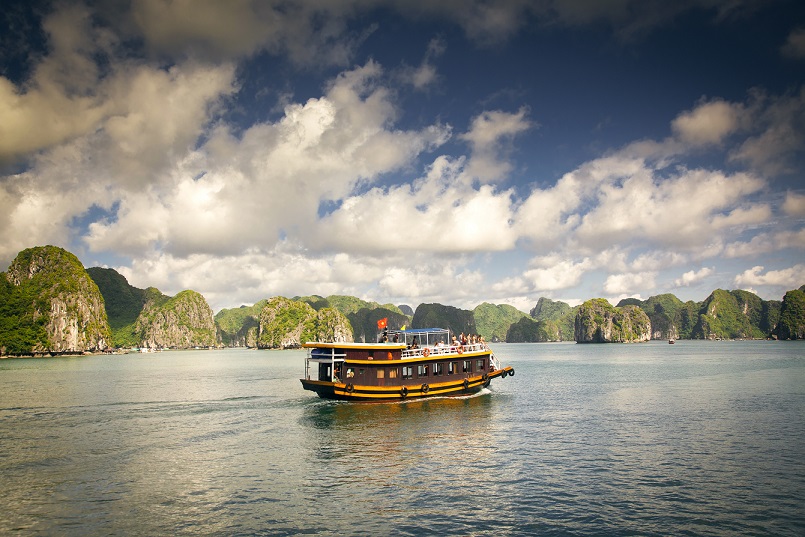
The number one must-see sight in the north and possibly the whole country is Halong Bay. You simply cannot leave Vietnam without experiencing it. Declared a UNESCO site in 1994, it’s been stated that this area is the world’s most extensive and best example of marine-encompassed limestone karsts. It even beat out Thailand for this title - quite a feat considering these rock formations are one of the most iconic images in The Land of Smiles!
Located in Quang Ninh province, 165 kilometers from Hanoi, Halong Bay is composed of 1,600 islands - almost all of which are uninhabited and untampered with by humans. This spectacular seascape can be enjoyed from cruise boats which take tourists out on day trips or overnight trips. Usually you’ll have a chance to swim and kayak as well, allowing you to get up close and personal with one of nature’s finest creations.

In 2003, this National Park in Quang Binh province joined the list of UNESCO sites in Vietnam. With over 100 kilometers of cave systems and underground rivers, this protected area is one of the most amazing limestone karst ecosystems on the planet. The caves that can be seen inside this park are some of the oldest in Asia and the Hang Son Doong cave has been declared the largest in the world.
Get below the surface with cave exploration tours that let you swim, hike, and spelunk to your heart’s content. If you prefer to stay above ground, the dense jungle growing on top of the cave systems is a treat for hikers seeking some remote trekking. Those who just want to relax and enjoy the natural surroundings should hit the Nuoc Mooc Ecotrail for some swimming, kayaking, and lounging at the small lake.
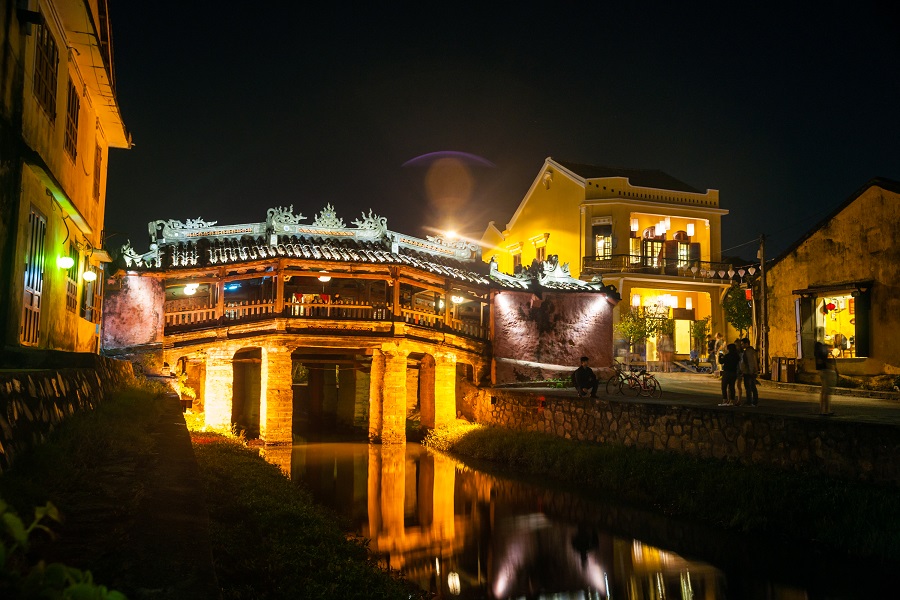
This city’s ancient town in the central Quang Nam province was honored as a Heritage Site in 1999 due to the excellent preservation of the ancient trading port. In fact, it remains as one of the best examples in the world of a South East trading port and commerce center. At its height of operation between the 15th -19th century, this port was one of South East Asia’s most important ports.
It’s the architecture in Hoi An Ancient Town that really makes this area so special. The cultural fusion between Chinese, Japanese, and European influence is obvious among the homes, shop fronts, and bridges. It also retains its original street plan and location, and still currently operates as a local port. Located on the Thu Ban River, another charming part of this city are the crisscrossing canals running through it.
Today, Hoi An charms travelers from far and wide with its historic waterfront now functioning as a riverside tourist attraction.
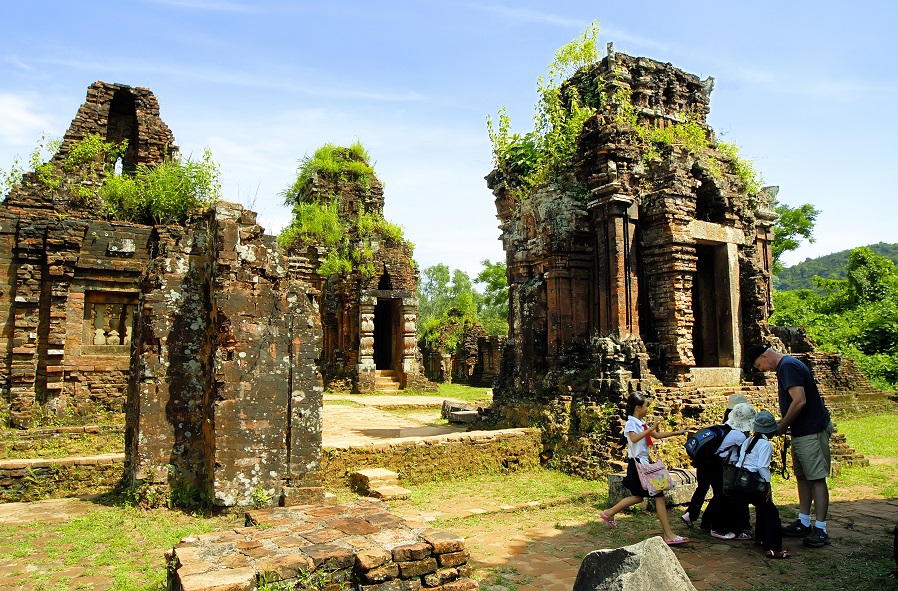
Also located in the central Quang Nam province and just over an hour’s drive west from Hoi An is My Son Sanctuary. This is the site of the ancient civilization of Champa, an independent country from the 4th to the 13th century before it became a part of Vietnam.
The ancient temples left behind show the Champa’s strong affiliation to Hinduismwith their specific style, sculptures, and structures. This area was not only the religious and political capital of the ancient Kingdom, but also a royal burial ground.
The remote jungle setting and shrubbery growth on the roughly 70 temples adds to the enchanting vibes felt as soon as this spiritual site is entered.
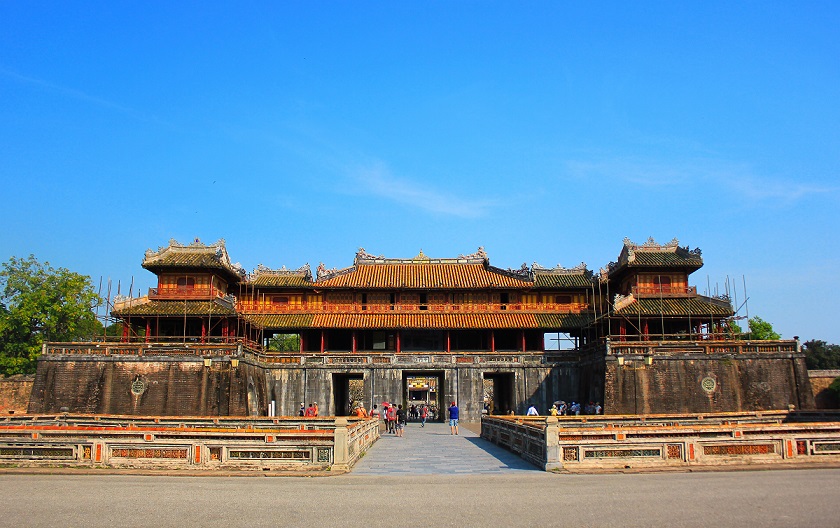
The city of Hue, located in the Thua Thien-Hue province, served as Vietnam’s political, cultural, and religious capital from 1802 to 1945. Framed by the Ngu Binh Mountains and dissected by the Perfume River, Hue is a very picturesque city in addition to being extraordinarily significant to the country’s history.
Hue houses many of Vietnam’s significant historical monuments. The Complex of Hue Monuments, named a UNESCO site in 1993, is highlighted by the Hue Citadel. This impressive building was the administrative center of southern Vietnam in the 17th and 18th centuries. Within the walls of the citadel also lies the Imperial Residence, Imperial City, and the Forbidden Purple City.
In addition to this central attraction, there are several other temples, pagodas, and fortresses scattered around Hue that are included in The Complex.
******
The aforementioned World Heritage sites showcase the various aspects of Vietnam’s wonders. Travelers can visit Halong Bay for seascape, Hoi An for culture, My Son Sanctuary and Hue for history, and Phong Nha-Ke Bang for nature.
Of course, if you have the time, all of Vietnam’s UNESCO sites are worth visiting. However, if you’re keeping to a tight schedule, then these four sites will allow you to get the most diversity out of your trip.

To this day, Hoi An still retains its Old World feel thanks to the extremely well-preserved area around the port. The original 17th and 18th century buildings show perfectly the fusion between Chinese, Japanese, French, and Vietnamese culture for which Hoi An is famous. It’s even earned itself an UNESCO World Heritage title.
Hoi An is a Vietnamese town that should be explored, appreciated, and savored. Read on to find out the must-see-and-do Hoi An highlights:
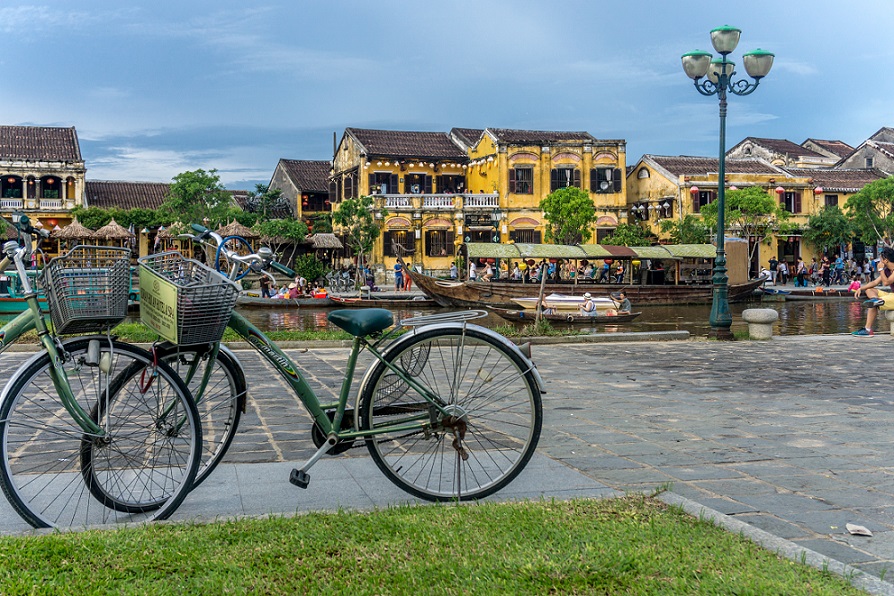
Set aside one day in Hoi An to rent a bicycle and get lost in the city’s Old Town. Cycle along the canals while admiring the French-colonial homes, Chinese temples, Japanese-style bridge, pagodas, and the old wooden store fronts. This section of Hoi An draws tourists and travelers from all over the world hopping to glimpse what life was like centuries before.
At night, the Thu Bon riverside is the most popular place for travelers to eat, drink, and hang out. Post up at an elegant bistro or laid-back local restaurant and watch the boat traffic on the river. This is definitely the most charming time and place for Old Town. Chock full of restaurants, bars, and set all aglow by hundreds of old-fashioned lanterns, you’ll find it hard to pull yourself away.
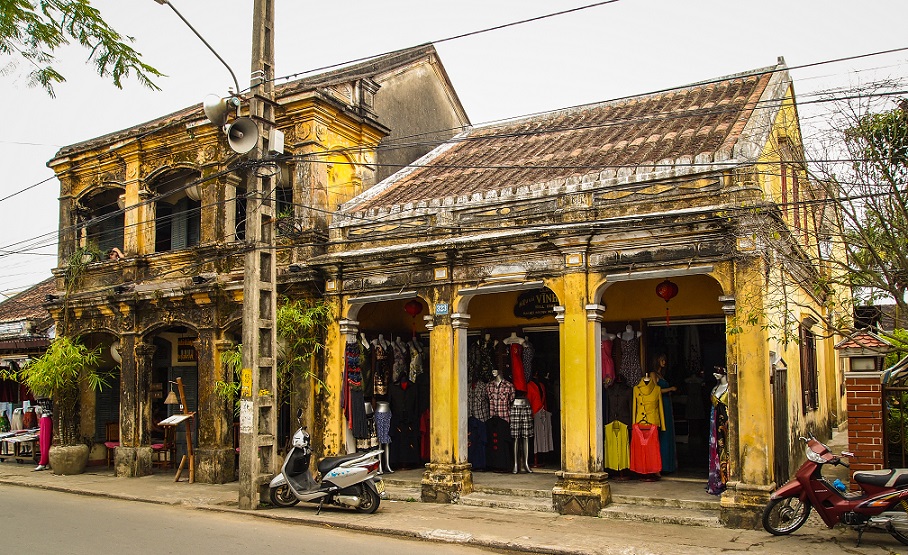
Hoi An is renowned for the number of tailors that operate in the city and the low price at which travelers can have anything they want tailor-made. This is the result of it being a trading port located on the Silk Road in its former life. Fast-forward to present-day and Hoi An has one of the densest population of tailors per capita in the world! This sounds cool until you actually go and try to pick a shop to produce the garment of your dreams. Then it becomes extremely overwhelming.
There is one important thing you should know about the tailors in Hoi An: not all of them are reputable. Many shops that advertise themselves as tailors are simply sales office. Once you’ve selected your fabric and been measured, the work is completed at an off-site location by someone else who may or may not be as skilled as you were led to believe. Also, working with a middle man results in many of the details of your future-garment being lost in translation.
In order to avoid the disappoint of a poorly made item, here are a few recommended Hoi An tailors: Be Be (known for their precision and promptness), Yaly (known for fancy and intricate detailing), Kimmy Tailor (in business nearly 50 years), and A Dong Silk (one of the best rated, professional shops in Hoi An).
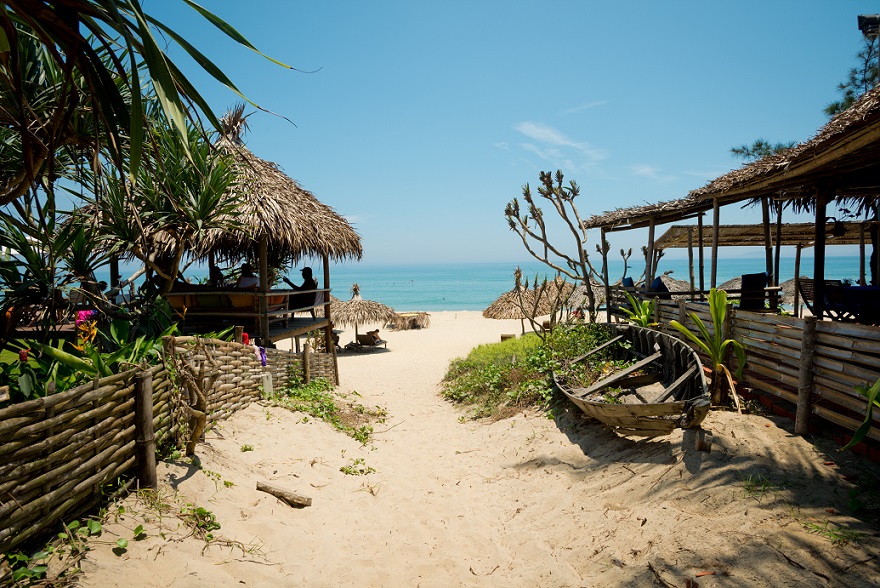
Escape the masses and head to Cua Dai Beach where you can snag your own piece of white-sand paradise with uninterrupted views of Cham Island in the distance. The 3km long beach is a considered one of the most beautiful coasts in the country. The beach remains relatively uncrowded during the week, making it feel like you’re one of the few to have made its discovery. Sunbeds and umbrellas are available to rent and hawkers patrol the beach selling refreshments and freshly-cut fruits. There’s also several seafood restaurants lining the beachfront. Although it’s only located 3km from Old Town, Cua Dai Beach feels like a million miles away from the hustle-bustle of the city.
An Bang Beach is another popular beach just a few kilometers further along from Cua Dai. An Bang is relatively undeveloped and therefore remains unspoiled when compared to many other beaches in Vietnam. There are a few water activities, including surfboard rentals if your visit falls between the surf season of September and March. There are various accommodation and dining options nearby and a few beach bars serving cold drinks and playing lively music well into the night.
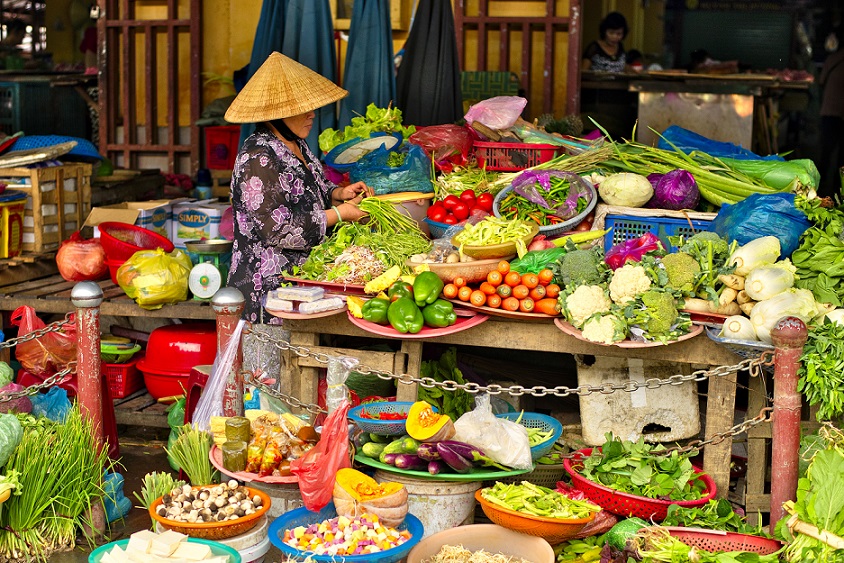
No trip to Vietnam is complete without a friendly haggle at the local market. Hoi An Central Market is located on the banks of the Thu Bon River in the Ancient Town, just 600 meters from the iconic Japanese Bridge. The market is a daily occurrence, starting at 6:30am and running all day. Get there early and witness the fish arriving at the docks, fresh off the boats.
Once you step inside the market and your senses will immediately kick into overdrive. The smells of herbs and spices, salty seafood, and sweet exotic fruits combine to create an intoxicating scent you won’t soon forget. The energy from the vendors is electric as they try their best to push their products on passer-byers. There’s also a tailoring section within the market offering some of the best deals on fabric and labor - just remember to heed our prior warning!
******
Even though these are the top four things to see and do in Hoi An, you’ll merely be scratching the surface of Vietnam’s most charismatic city. Travelers visiting Hoi An should spend a little extra time and effort uncovering its secrets as there’s a certain magic here not found anywhere else in the country.
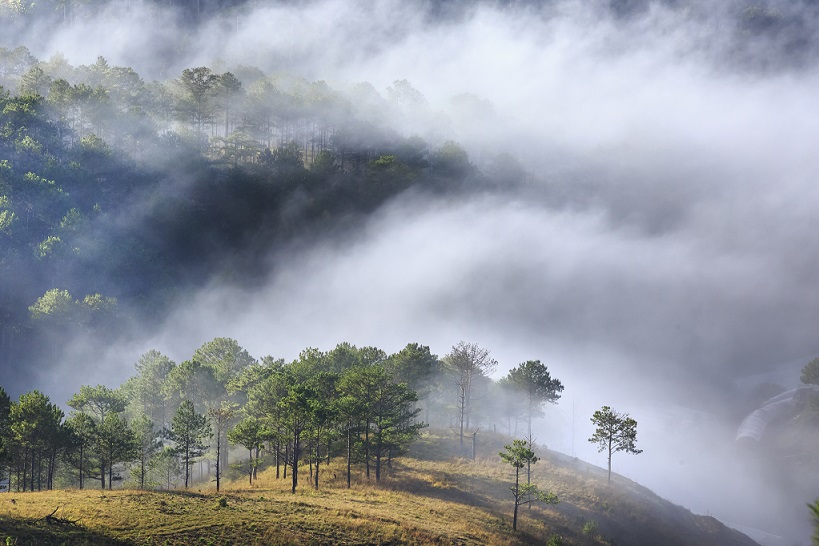
The Weird and Wonderful Dalat city, Vietnam
This mindset results in one of the best reasons to go to Dalat in the first place! The obvious lack of young backpackers here makes it feel a lot more authentic than the other heavily trafficked places in Vietnam. Combine this with the city’s naturally beautiful surroundings and some kooky attractions, and Dalat is high on the list of must-see cities in Vietnam.
Here are some of the best things you can see and do in Dalat:
Entrance Fee: $1 USD
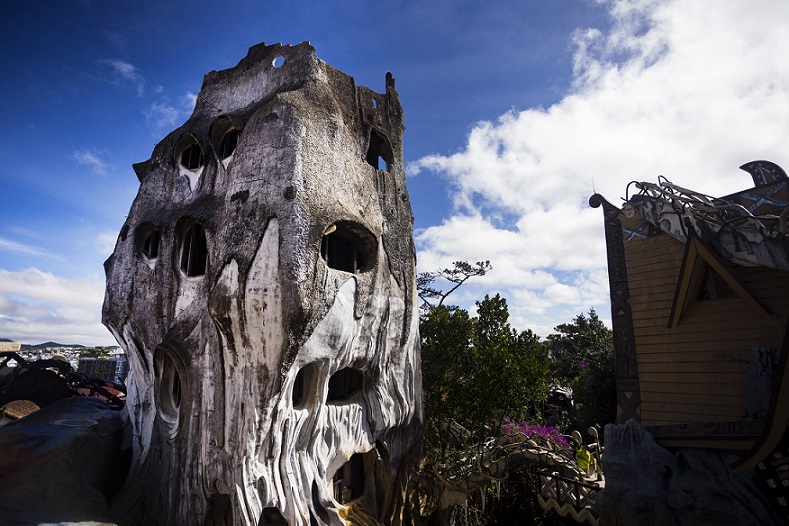
This is definitely Dalat’s most interesting attraction. Commonly referred to by its nickname “Crazy House”, this bizarre building is an iconic sight in Dalat. The design and architecture are the brainchild of the Soviet-trained, Vietnamese architect named Dang Viet Nga. Built in 1990, this oddly constructed guest house boasts around twelve rooms on multiple lopsided stories. Resembling a massive tree house, the rooms are connected by twisting tunnels and winding staircases.
Even if you’re not staying in the guesthouse, you can still enter for a self-tour around the property - and you totally should!
Entrance Fee: $0.50 USD
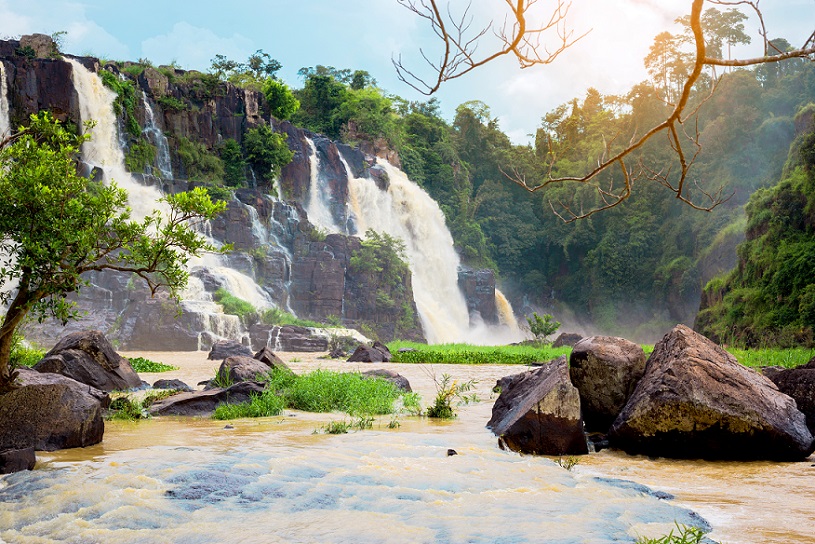
Lying on the outskirts of the city, this waterfall’s location in the middle of nowhere adds to its mystic. As one of the largest falls in Vietnam, Pongour is roughly 20 meters high and 100 meters wide. The multiple tiers of rocks create dozens of asymmetrical cascades makes for a really impressive sight. You can even climb up these tiers to paddle your feet or swim in one of the small pools.
Pongour fall is also a popular picnic spot for the locals - grab a drink or a snack at one of the small stalls nearby and join in.
Price: $50 USD
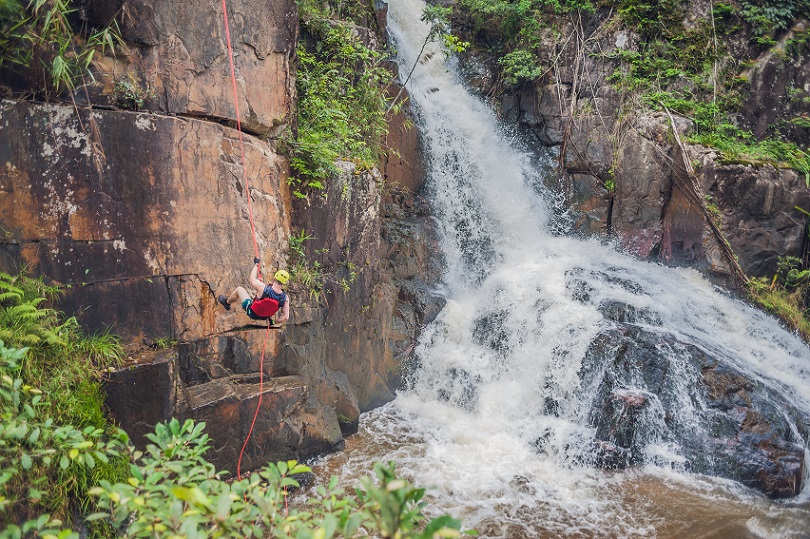
There’s no better place to rappel off the side of a waterfall than Dalat! With plenty of cliffs, canyons, and falls to explore, a canyoning day-trip is a one of a kind way for the more adventurous travelers to discover Dalat’s natural beauty. Most day-trips include transportation to Datanla Waterfall, light trekking, several opportunities for dry abseiling, swimming, cliff jumping, and experiencing a “natural” water slide. The grand finale is rappelling off a 14-meter waterfall.
Price: Free
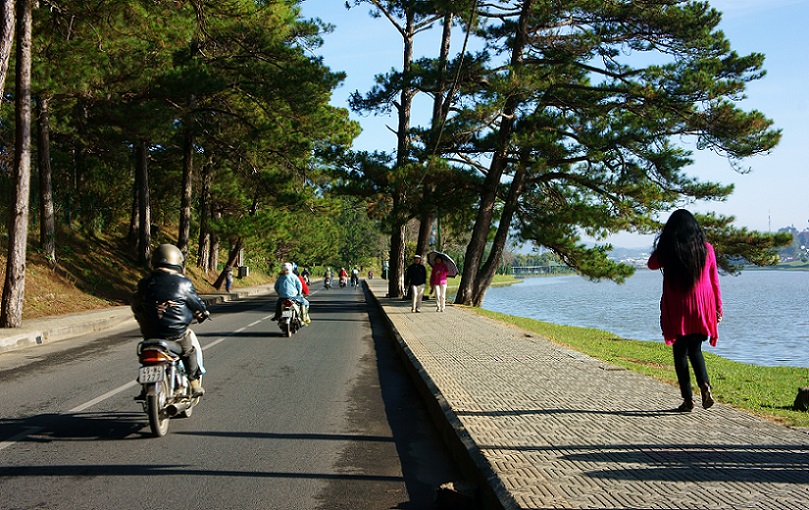
The Dalat city center is definitely claimed by Xuan Huong Lake. Many locals and tourists come to walk, jog, and bike the 7-kilometer path that traces the outline of the peaceful, man-made body of water. It’s also a very popular spot for honeymooners!
Around its perimeter you’ll find hotels, markets, gardens, and a golf club. There are also paddle-boats and swan boat rides available for those who just can’t resist getting out on the water. Stop in at one of the nice cafes for a leisurely drink and lakeside views. However you choose to enjoy it, this is a truly peaceful place in Vietnam where time stands still.
Price: Free
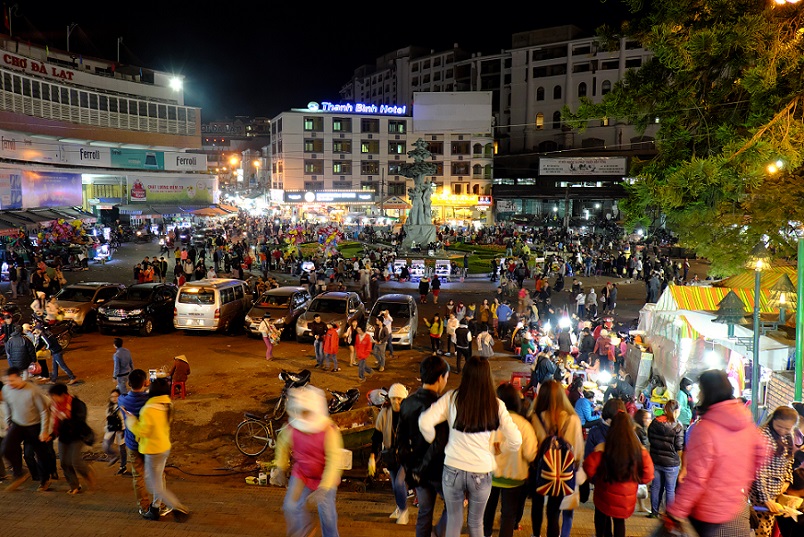
Also dubbed the Night Walking Town due to its sprawling size and plentiful options, Dalat’s Night Market is a lively and atmospheric place in which to wander. Located in the Hoa Binh Zone - the city’s only functioning market area - the market comprises multiple streets near the Hoa Binh Theater including Tang Bat Ho, Truong Cong Dinh, Nam Ky Khoi Nghia, a part of Nguyen Chi Thanh and all of Nguyen Thi Minh Khai.
The shops and stalls are lit with neon lights, setting the whole area aglow every weekend evening from 5:00pm-10:00pm. In one section, handmade woolen goods are displayed and sold from large pieces of canvas spread on the ground. Tourists can trust the genuity of the ethnic fabrics found here.
Another section is all about the food. One of the best ways to enjoy a cool or rainy evening in Dalat is to post up under an umbrella on plastic chairs and order a steaming hot-pot while the madness of the market swirls all around you.
That’s not all - you’ll also stumble across street performers, new and second-hand clothing stalls, souvenirs, and fresh produce. There’s literally nothing the Dalat Night Market lacks.
**********
These are just a few of Dalat’s many highlights. If you take the time to explore further, you’ll easily find dozens of other reasons to love the weird and wonderful Dalat.

Are you backpacking in Vietnam soon? If so, then you’re making the right decision. With striking nature landscapes, long stretches of gorgeous coastlines, cheap accommodation, and vibrant local culture, Vietnam is definitely a perfect backpacker destination.
The best time to go backpacking in Vietnam is in spring, which is between the months of February and April, and in autumn, from August until October. In spring, the months of March and April enjoy the lowest rainfall, although the temperature across all destinations during this time of the year is pleasant.
Vietnam is divided into two regions, the south (Ho Chi Minh City) and the north (Hanoi). If your time in Vietnam is limited, you can simply focus on one region. Otherwise, if you have a month for your trip, then you can explore from the north to south or the other way around.
If you want to visit the southern part of Vietnam, your trip will most likely begin in Ho Chi Minh City (Saigon). Aside from Ho Chi Minh, here are the other places you can visit in the southern part of Vietnam:
If you want to focus your Vietnam trip in the North, then your trip should begin at Hanoi, Vietnam’s capital city. In the north, here are the other places you can visit:
There are plenty of affordable backpacker accommodations in Vietnam. The standard accommodation in most of the tourist areas in the country is excellent. There are plenty of accommodations that cater to budget travelers and backpackers, especially in the main tourist hubs of Ho Chi Minh and Hanoi. Prices are slightly less expensive in Southeast Asian standards, however the quality is definitely much better. Competition is stiff and with construction boom currently going on in the country, now is the best time to visit, as the cost of accommodation is generally low and the standards of service remain high.
Vietnam is one of the safest countries to visit for all kinds of travelers, including solo backpackers. However, in major cities like Ho Chi Minh and Hanoi, pickpocketing incidences is still an occurrence, so you have to be mindful of your belongings when walking the busy streets. Moreover, the streets of Vietnam are pretty chaotic, so you have to be careful when walking the streets, as there are plenty of motorcycles zooming around.
The motorcycle is a big part of the tourism of Vietnam, but you have to exercise extreme caution when riding or driving. Always wear your helmet and make sure you have a driving license, or you could get penalized with a hefty fine.
Backpacking in Vietnam is really cheap, but you could end up spending more if you don’t come prepared. Hopefully, this guide can help you in planning your backpacking adventure in this beautiful Southeast Asian nation.

A UNESCO World Heritage site and national park, Phong Nha-Ke Bang is riddled with caves and is home to the oldest karst mountains in Asia. Located on the north central coast region of Vietnam, the national park was originally created to protect one of the world’s two largest karst regions, consisting of 300 caves and grottos.
Son Trach town is the main centre for accommodation and restaurants. With a population of just 3000, the small town is becoming much more popular with hostels and hotels opening. The caves are the absolute highlight of the national park and tourists flock to see one of the many caves in the area. Two days spent in the national park is a perfect amount of time to soak up the sights, history and culture.
A day trip to Paradise Cave and Phong Nha Cave is a brilliant way to spend your time. Phong Nha has three public caves in total and they are much more affordable options than Hang Son Doong cave which costs $3000 and is not easy to get to.
Phong Nha Cave will take around three hours in total to see and includes a boat trip there and back. A very beautiful and serene journey and you have the option to see Then Song Cave whilst there. Unlike Phong Nha Cave, Paradise Cave can easily be reached by motorbike. The journey offers spectacular views throughout and gives you a chance to go at your own speed.
Delicious food and a great atmosphere, head over to D-Arts Zone in Son Trach town in the evening. The menu includes fried spring rolls and smoked sausage from the restaurant’s barbecue grill. Sit out on the wooden table and chairs and enjoy your evening after a long day of exploring.
On day two, head to the Dark Cave for an adventure. While visiting the Dark Caves, you have the opportunity to swim, kayak and zip line in the cave. A completely different experience from Phong Nha and Paradise Cave. Although it only takes a couple hours to visit the cave, there are some hot springs nearby that are well worth a dip.
Next head off to the botanical gardens which offer fantastic treks. You can find the entrance to the gardens right by the Phong Nha park entrance. There are three hikes available, all leading to a waterfall at the end. The shortest trek is only 1km and heads straight to the waterfall. Depending on your capability and energy levels, you can decide which hike is more suited for you.
After two days back to back exploring caves and jungle, take some time to relax, have a drink and meet some fellow travellers. Easy Tiger Hostel is a lively, social hub of activity for visitors. As well as a great place to have a drink, they can also arrange tours and shuttle buses. The hostel regularly has entertainment and has 104 rooms available if you’re looking for a place to stay.
If you’re serious about visiting the more restricted caves such as Son Doong Cave and Hang En, Oxalis Adventure Tours are the only official company allowed to operate commercial expeditions in the caves. Phong Nha-Ke Bang National Park offers up breathtaking scenery and a unique landscape perfect for exploring. Make the most of the time you have and enjoy every minute.

Since 2008, Indian passport holders are eligible for e-visa of Vietnam (30 days, single entry). You can apply online at the official website of the government of Vietnam https://evisa.immigration.gov.vn or if you are not confident to apply at the official website, you can apply online through our website with 100% money back policy.
In case you want to stay for more than 30 days or want to get multiple entry visa, it is best that you avail the Vietnam Visa on arrival. The Vietnam visa on arrival processis pretty simple. This has been considered to be the first and a preferred option for all of the people who require Vietnam visa for tourism purposes. Since 2005, Indians can apply for visa on arrival Vietnam through a travel agency in Vietnam, no need to queue at the embassy of Vietnam anymore.
Now, the Indian citizens, like the citizens of any other place, can apply for a visa through the same procedure. Every applicant needs to enter their detailed personal information on the form. When talking price, the visa on arrival is best chosen by the people. It is very cheap when compared it to embassies’ charges and helps save money. These prices can turn out to be even better if a group of people applies together. The documentation and verification procedure requires time but when you are availing visa on arrival, you can be pretty sure that the procedure is done at full speed. When applying for visa on arrival, you have the ability to apply from any part of the world, be it UAE, India, Singapore or Malaysia. You can even apply for such visa online without having appointment beforehand.
Vietnam visa on arrival means that the visa is handed down to the person at the arrival section of the airport, however, the travelers must hold a visa approval letter from the Immigration Department of Vietnam then able to pick up their visa on arrival.
Just find a reliable website offer best price then submitting the application for the visa approval letter, then the website owner will arrange the approval letter and send it to your email. This must be done before flying off to Vietnam. There is not even a single airline which will allow you to board the flight if you do not have the approval letter. It is required to be shown at the check-in counter. The airlines will require showing the approval letter. Thus, it is highly essential that the approval is taken before departure.
If you have a valid passport, 2 photographs and the required fees, we can help you get Vietnam Visa on Arrival letter at Vietnam immigration department, print it, and get it stamped.
There are two different parts of procedures:
1. Vietnam visa process for tourist visa application
For the tourist visa (category DL), please remember to choose purpose of your visit is for tourist when you filling out the visa application form online. Once the application is made, the next step is to proceed with the payment.
The most commonly found problem that the Indian citizens make while filling the form is entering the entry / exit date, their date of birth section. There is a particular format to enter the date in Vietnam – dd/mm/yyyy. Consider an example, you were born on 12th July 1978, you will have to enter 12/07/1978 or 12/Jul/1978.
2. Vietnam visa process for business visa application.
Applicants seeking a business visa (category DN), please remember to choose purpose of your visit is for business when you filling out the visa application form online. It is confirmed that there is no document required except the copy of your passport.
After this processing is completed, normally 2 working days, the website owner will send you a visa approval letter with instructions to your email address, please to check your email including spam box or junk box to make sure you got it before going to Vietnam.
On the arrival airport of Vietnam, you will see the landing visa counter also called visa on arrival desk, you will need to submit your original passport, printed copy of approval and completed the entry and exit from with a passport sized photo then wait to be called to pay for stamping fee and get back your passport with the visa inside.
To make it easy and hassle free for you, we can help you with every aspect of obtaining a Vietnam Visa on Arrival. Contact us for a seamless Visa experience.
The flavors and freshness of Vietnamese cuisine are irresistible. You’ll find a vendor selling something that looks and smells delicious on every corner. It’s only natural that you’d want to sample it all, but unfortunately there’s so many amazing foods in Vietnam that this may not be possible. Our recommendation is to try as much as possible, however below you’ll find eight dishes that you simply cannot leave Vietnam without trying:

The most well-known Vietnamese food is probably Pho, and for good reason. This savory, satisfying soup is a staple in Vietnamese cuisine, and you’ll primarily see people eating it for breakfast. However, feel free to order a bowl whenever you want; there’s never a bad time for Pho. This beloved soup starts as rice noodles bathed in a tasty broth, typically followed by some form of beef (if you’re a vegetarian, skip the meat). The soup is then topped with bean sprouts and a spattering of greens like basil and green onion. Pho is served with salty, spicy, fermented fish sauce and a lime wedge. This is a popular dish that’s been adapted in restaurants worldwide, however Pho is an absolute must-try in its country of origin.
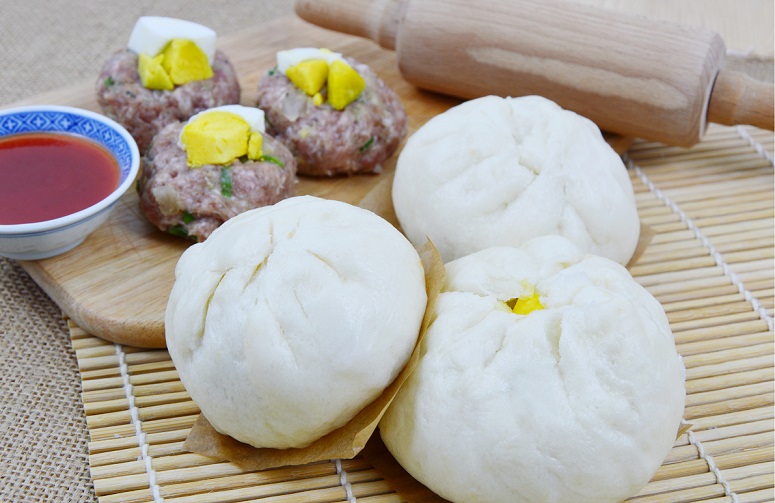
This soft, doughy, ball of steamed white bread is a common breakfast food or mid-day snack often sold from mobile street vendors. The bun is typically filled with pork and half a hard-boiled egg or quail egg, however there are many other varieties including BBQ pork, chicken, or vegetarian-friendly options. There are even sweet buns, stuffed with a custard-y filling, or the purple-colored buns which usually contain sweet potato.
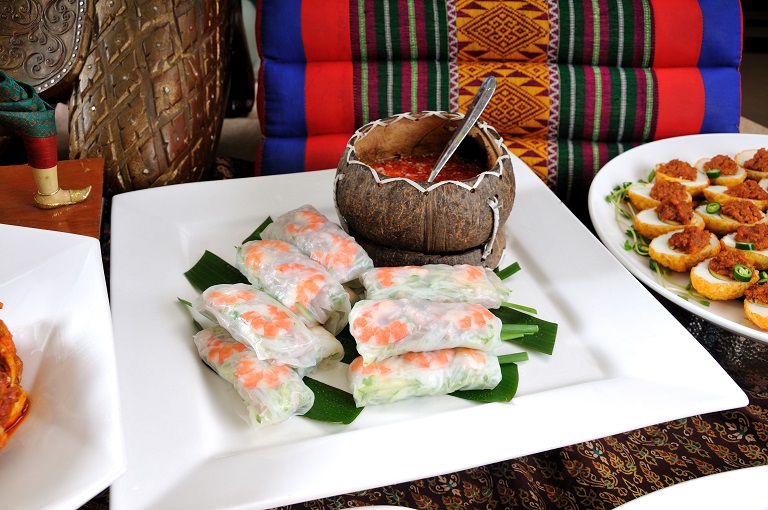
These are the freshest spring rolls you’ll ever taste. The transparent rice paper outside wraps up greens, coriander, pork, and prawn in a perfect bite-sized package. Gỏi Cuốn is served with a savory dipping sauce topped with crushed peanuts and spicy chili peppers. Usually a little mint or basil accompanies the dish on the side. These are a great choice if you’re looking for a healthy appetizer. If you’re not too bothered about the calories, you can also order them deep-fried (called Nem Rán or Chả giò).
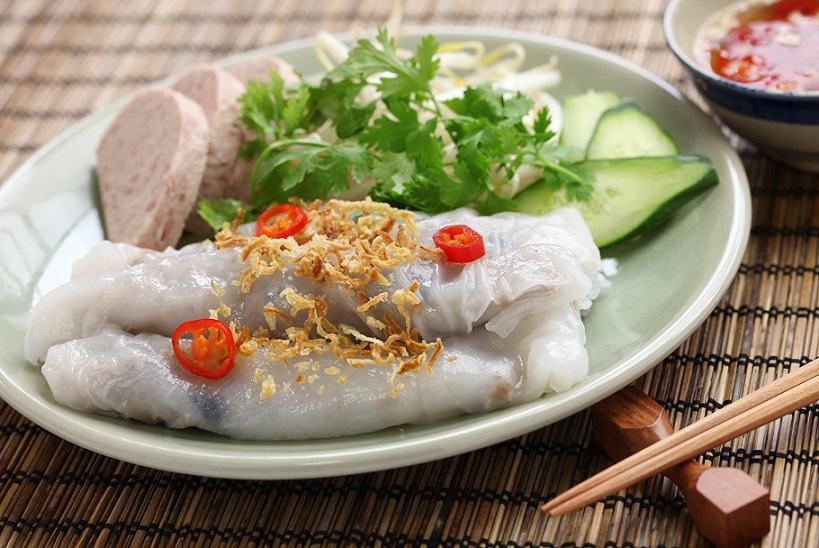
Banh Cuon translates to ‘’rolled cake’’, which is a pretty accurate description of what it is. This scaled-up version of the spring roll packs a few more ingredients than its slimmer counterpart. The main components of the rolled cake is a ground meat (pork, chicken or shrimp) and various vegetables like mushrooms, bean sprouts, onion, and cucumber all wrapped up in a steamed translucent rice paper. It’s a perfect grab-and-go snack favored among travelers who need to stay fueled and energized for all that sightseeing.
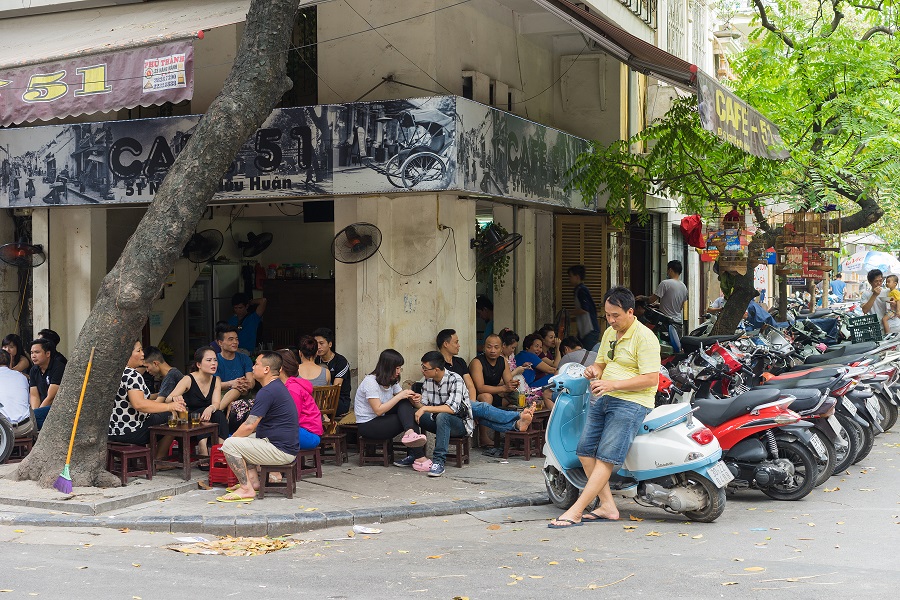
If you’re looking to jump-start your day or need a little kick in the afternoon, look no further than Vietnamese coffee. Once you order a cà phê, you’ll get to watch your drink brewed right in front of you. You’ll be served a petite glass coffee cup with a metal French drip plunked right on top of the glass. The dark roast slowly drips through the filter and into your cup. It’s common for Vietnamese coffee to be served with condensed sweet milk on the side or already portioned out in the coffee cup. The combination of the milk’s sticky sweetness and the coffee’s flavorful bitterness is unmatched by any other cup o’ Joe in the world.
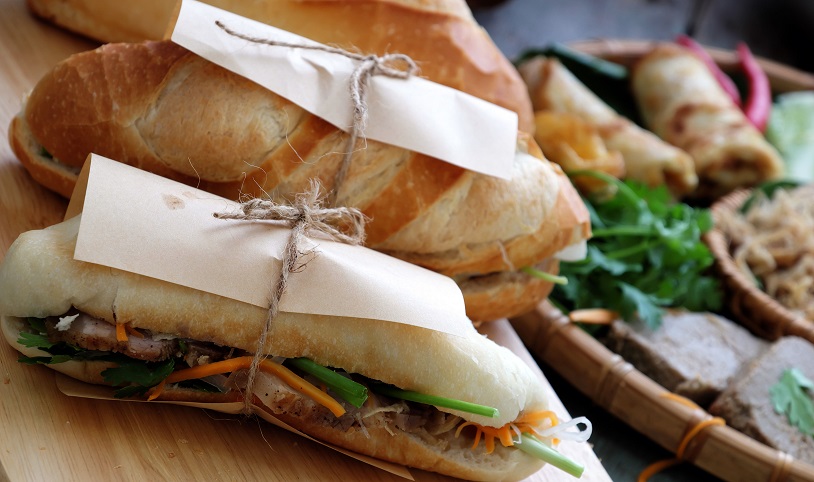
Best described as a French-Vietnamese fusion sandwich, this is one of Vietnam’s tastiest and cheapest quick meals. A French-style baguette is toasted with butter, spread with a salty pate, stuffed with fresh and pickled vegetables, and includes your choice of meat or protein filling (pork, fish, chicken, or egg/omelet). One of these will run you roughly $1, which means you can totally afford to come back for seconds.
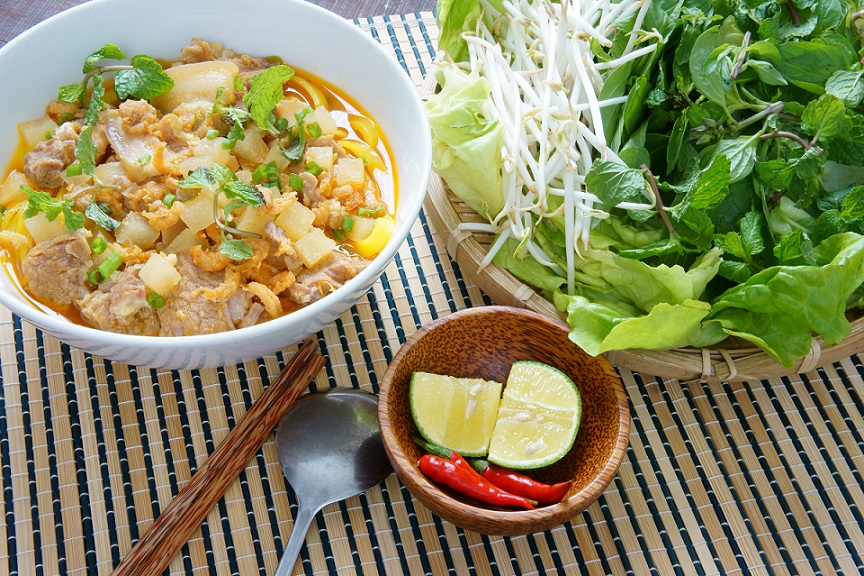
If a big bowl of carbs is what you’re craving then Mi Quang fits the bill. Rice noodles seasoned with turmeric and bone broth are topped with pork, quail eggs, and shrimp. It’s served with a plate of greens (like many dishes in Vietnam) with basil, mint, and lettuce. Cheap and filling - just what every budget backpacker needs.
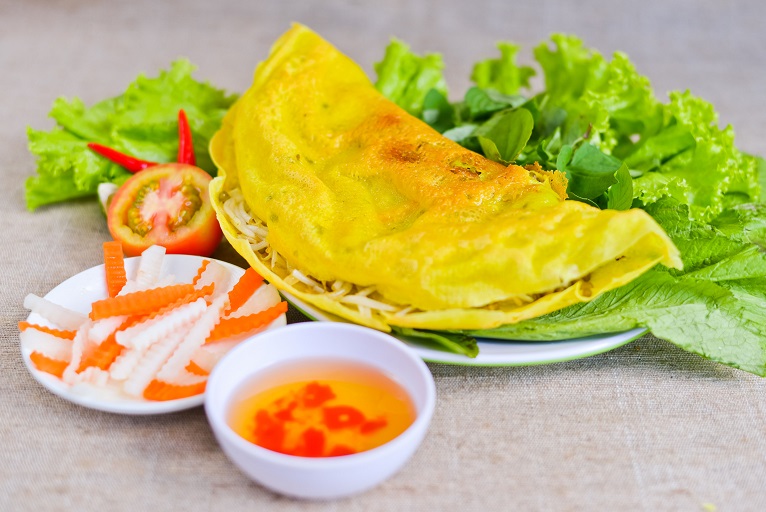
It’s hard to resist the sound and smell of pancake batter frying in a pan and that’s exactly what makes Bánh Xèoone of Vietnam’s best foods. Literally translating to “sizzling cake”,Bánh Xèo is a cross between a sweet crepe and a savory omelet. The batter is made from rice flour, coconut milk, and turmeric. The mixture is fried in a skillet, then filled with bean sprouts, green onion, and thinly sliced pork or shrimp. This dish is typically served with a bunch of greens which you can use to wrap up torn off bits of the Bánh Xèo. Stuff a few mint or basil leaves in the wrap, then dunk it in the salty, fermented peanut sauce. Now you’re eating like a local!
************
If there’s one rule of thumb for traveling in Vietnam, it’s to come hungry and eat often. The only mistake you can make is leaving the country without trying one of our top 8 picks!

Beginning your Vietnam adventure in a Hanoi is the best decision. It’s possible to spend weeks in the capital city exploring the side alleys and offshoots, finding all the hidden local spots, and befriending the other expats that have made Hanoi into their temporary home.
Of course, there are many things Hanoi is famous for that should also be experienced by someone visiting the city for the first time. What makes Hanoi such an exceptional starting point for traveling the country is its proximity to many other must-see attractions.
Below, we’ll guide you through some of the coolest, craziest, can’t-miss attractions in and around Hanoi!
Arriving in Hanoi can be overwhelming. Finding a cool hostel or guest house that hosts lots of activities makes discovering Hanoi a whole lot easier. Search for accommodation in the Hoàn Kiếm district for a high concentration of popular hostels with lively atmosphere.
*Many of these backpacker-friendly guest houses hook their guests up with access to a free city walking tour. Taking one is strongly recommended! This is the best way to discover a few hidden spots, learn a little something about the country from your local guide, and get your bearings in Hanoi.
After your city tour, be sure to check these attractions off your list:

This is like Hanoi’s equivalent to New York City’s Central Park. Popular with both locals and tourists during all hours of the day and evening, this oasis serves as an escape from the otherwise frantic pace of the city. TheNgoc Son Temple sits on a small island in the middle of the lake, connected to the land by a brightly-painted bridge. This is a great place to come to relax and people watch.
The best place to experience this one-of-a-kind Vietnamese art form is at Thang Long Water Puppet Theatre. Located on the iconic Hoàn Kiếm Lake, this theater has the best reputation in town. The stage is water and the puppets glide across the surface, telling ancient legends, folklore and stories of the rice harvest. A (loud) orchestra accompanies the puppets as they put on their show.
Yes, you read that right. In Hanoi, it’s possible to go to a snake restaurant. Here you’ll be introduced to your snake and watch it killed in front of you. The wildest part is you’ll also have the opportunity to eat the heart right out of the snake after it’s been cut! Afterwards, a multiple course meal is prepared entirely from the snake - including snake ribs. What’s on the drink menu? Snake blood, bile, or a mixture of the two. Of course, this activity is not for everyone, but it’s certainly a crazy way to spend an evening in the city.
This area is fascinating and fun. Wander around and admire the colonial architecture, observe the organized chaos of the traffic, and browse the numerous fruit and vegetable street markets and small shops. This is also the best place to enjoy cheap eats, like the famous Vietnamese Pho or Bánh Bao, a soft white bun with savory filling.
Drink a $0.25 beer
While you wander, you’ll likely stumble across several makeshift corner bars. These bars pop up on corners all around Hanoi and consist mainly of a keg of Bia Hoi and plastic tables and chairs. Take a load off with the locals and grab a plastic cup of the cheapest beer you’ll ever pay for.
While Hanoi is a super fun and exciting city, there’s also so much else to do nearby. Check out our picks for the two trips that are an absolute must:

This enchanting World Heritage seascape is definitely one of Vietnam’s most breathtaking sights. Halong Bay’s emerald-green water dotted with 1,600 limestone karsts and topped with vivid greenery is like a page straight out of a fairy tale. It’s a truly unbelievable sight - rain, shine, or fog - Halong Bay must be explored.
Halong Bay is about 3.5 hours from Hanoi, however it is possible to squeeze the whole experience into a day trip. The best way to see Halong Bay is, of course, by boat. There are plenty of options for boat tours, ranging from budget to super-luxury. Some boats may offer overnight packages. Mid-range to high-end cruises typically offer sea kayaking as part of the deal.
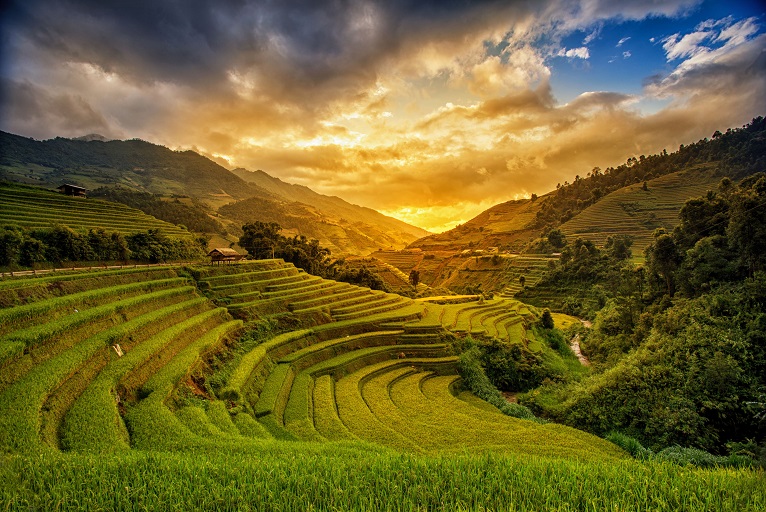
Way up in the northern corner of Vietnam, over 300 kilometers from Hanoi, travelers find a welcome relief from the frenzied city’s heat and grime. Sa Pa, nestled deep in the Hoang Lien Son mountain range, is the trekking mecca of Vietnam. Sa Pa’s famous landscape of bright-green rice paddies rising and falling between the mountains and valleys carry on as far as the eye can see. The lush vegetation of the region’s countryside emanates the kind of peaceful serenity that accompanies the simple lives still led among the village tribes that call Sa Pa home. Trekking through the area and spending the night in a homestay is the best way to discover this captivating area.
Most people take the night train from Hanoi to Lao Cai Railway Station. The journey is about 8 hours and most have sleep beds in each car. You can also take an overnight bus or express bus (day time) from Hanoi.
From the hectic city life of Hanoi, to the mysterious waters of Halong Bay, to the tranquility of Sa Pa; no trip to Vietnam could be considered complete without experiencing them all.